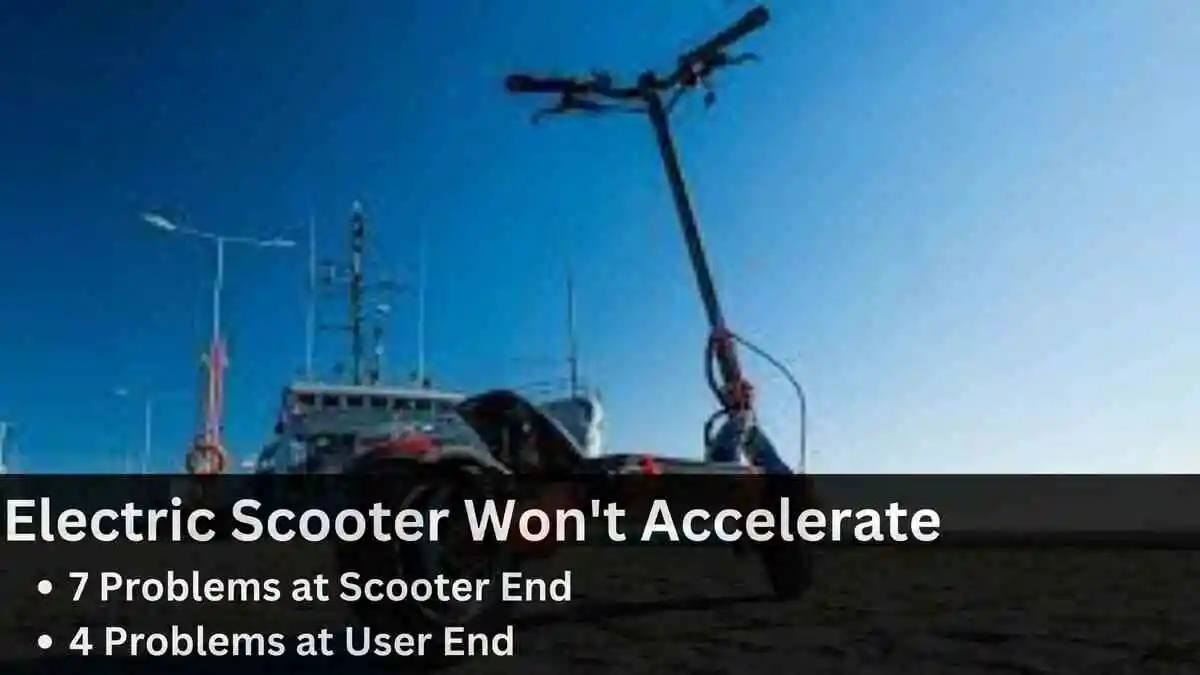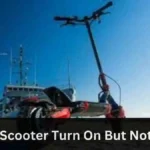Are you experiencing sluggish acceleration?. Don’t fret; you’re not alone! Electric scooters are fantastic tools for getting around town, but just like any machine, they can sometimes encounter performance hiccups like throttle not giving any acceleration.
The good news is that many of these issues can be addressed without too much hassle. In this article we will guide you through the problems that cause electric scooters to not accelerate, we’ll see why does my electric scooter turn on but not move, and how to solve electric scooter won’t accelerate.
Why Electric Scooter Won’t Accelerate Properly:
Here we have divided the potential causes in Two categories as follow:
Problems at Scooter End:
When your electric scooter refuses to accelerate, it’s essential to diagnose the root causes and find effective solutions. Here’s a structured overview of common issues and their respective remedies
1. 0% Battery:
The speed controller, positioned between the battery and motor, incorporates a low voltage cutoff feature. This feature automatically deactivates the motor when the battery or battery pack reaches a 0% charge state.
This protective cutoff function safeguards against over-discharging the battery pack.
Solution:
Charge the electric scooter first and then try the electric scooter to turn on and accelerate.
2. Damaged Throttle:
A damaged throttle can result in either no acceleration or erratic acceleration behavior.
Solution: Here are the steps to fix a damaged throttle on your electric scooter, explained in simple terms:
- First, figure out what’s causing the problem with your throttle. It could be because of bad connections, a broken throttle lever, or some damage.
- Remove the cover on the top deck of your scooter to see the wires. Make sure these wires are firmly connected. If they’re loose, tighten them up.
- If your throttle is still not working properly or it’s damaged, you can buy a new throttle assembly for your specific electric scooter.. Replacing it involves taking off the handlebars and disassembling them to access the throttle assembly.
- After you’ve replaced the throttle assembly, check if it’s working correctly. You can do this by twisting, turning, or pushing it, depending on the type of throttle your scooter has.
- Finally, turn on your scooter and test the e-scooter fuse to make sure it’s working as it should.
By following these steps, you should be able to fix a damaged throttle on your electric scooter.
3. No Voltage to the throttle (If throttle is fine):
When the power from the battery doesn’t get to the throttle correctly, it can mess up how your electric scooter speeds up. Here are some reasons why this might happen:
- Broken Controller: If the part that controls the power is broken, it can stop the battery’s power from reaching the throttle and make your scooter slow.
- Wiring Problems: If the wires that carry the power are loose or broken, they won’t let enough power reach the throttle, and that can slow down your scooter.
- Voltage Drop: Sometimes, when you speed up, the power in the battery can drop a lot. This is called “voltage sag,” and it can also make your scooter slow down. It can happen if the battery or the motor isn’t working right
Solution: Check for any problem with wiring or controllers, in these cases you need to change the wiring with perfect wiring cables that are good for electric scooters.
If there is a voltage drop or sag issue which can be checked by a voltage meter. You can see if the current is reaching or not to the throttle if not and even if the battery is perfect, then go for changing the wiring cables from battery to motor and their connection with the throttle.
4. Battery Issues:
Battery-related problems, such as an aging or worn-out battery, can hinder full-throttle acceleration.
Solution: Inspect the battery and its pack to verify their condition and charge levels. Ensure they are in good shape.
5. Improper Settings:
Issue: Incorrect settings, such as being stuck in slow-speed mode or having improper P-settings (also known as parameter settings), can impede proper acceleration.
They’re usually found on your scooter’s display or control panel.
Here’s how P-settings can affect how fast your scooter goes:
- Cruise Control (P1): You can set a specific speed for your scooter to maintain, and that can affect how quickly it accelerates.
- Minimum Voltage (P2): This setting decides the lowest power level your scooter needs to work. If it’s too low, it can make your scooter accelerate slowly.
- Drive Mode (P3): You can choose between using one motor or two. This choice can affect how fast your scooter accelerates.
- Max Speed (P4): You can change the top speed of your scooter, which can change how it accelerates.
- Acceleration (P5): This setting lets you control how fast your scooter speeds up from a stop.
- Regenerative Braking (P6): You can adjust how much power goes back into the battery when you brake. This can also impact your acceleration.
- Motor Timing (P7): Changing this setting can affect how your scooter accelerates and performs overall.
- Max Speed Setting (P8): Like P4, this setting lets you adjust your scooter’s top speed, which in turn affects acceleration.
- Electric Brake Strength (P9): You can change how strong the electric brake is, and this can also change your scooter’s acceleration.
Solution: Review and adjust the settings to match your desired performance. If you’re not sure what you’re doing, it’s best to check the manual or ask a professional technician for help.
6. Bearing Problems:
If the little parts inside your electric scooter, called bearings, are broken or too old, they can make the scooter shake and make noise when you speed up. This can mess up how well your scooter works.
Messed-up bearings can even mess with the motor that makes your scooter go.
Solution: So, it’s a good idea to keep an eye on your scooter’s bearings and change them if needed. You can find new bearings on Amazon to fix your scooter up.
7. Motor Issues:
Motor problems, including damage or wear, can disrupt the scooter’s acceleration.
Solution: Contact Customer Support or buy replaceable motors.
- Razor: Visit https://razor.com/contact-support/ for phone numbers and email addresses for Razor’s customer support team.
- GoTrax: Visit https://gotrax.com/pages/contact for phone numbers and email addresses for GoTrax’s customer support team.
- LaScoota: Visit https://lascoota.com/pages/contact for an email address to contact LaScoota’s customer support team.
- Hover-1: Visit https://www.hover-1.com/pages/support for a contact form and phone number to get in touch with Hover-1’s customer support team.
- Hiboy: Visit https://www.hiboy.com/pages/contact-us for an email address to contact Hiboy’s customer support team.
Problems at User End:
1. Over Charging:
Overcharging an electric scooter can result in a decreased ability of the battery to hold a charge, leading to accelerated degradation compared to regular wear and tear.
Additionally, the scooter’s motor can sustain damage from overcharging, excessive usage, and the strain associated with extreme riding, resulting in potential issues such as malfunctions, melting, or even the combustion of various components of the electric scooter.
So don’t charge electric scooter on different voltage and time recommended by manufecturer’s.
2. Weight Capacity:
The weight of the rider is another factor in the acceleration equation. Here’s how it comes into play:
Heavier riders demand more power, which can drain the battery faster and reduce acceleration over time. If you’re on the heavier side, you might need a scooter with a beefier motor to maintain good acceleration. Look for a more powerful model.
3. Rider’s Body Position:
The way you position your body while riding affects acceleration:
- Leaning Forward: Leaning forward and shifting your weight towards the front of the scooter can improve acceleration.
- Maintaining Stability: Keep your feet comfortably apart for stability and better acceleration.
- Handlebar Control: Avoid excessive or jerky movements of the handlebar to maintain stability and acceleration.
4. Terrain Type Impact on Acceleration
Some users buy electric scooter that is not good for their daily routine use.. They either need to highly customize it or buy a new one.
if you want any scooter for your terrain you can write your comment in the article below and we can suggest it to you there.
Here are the terrain types and their effect on electric scooter acceleration:
- Uphill Rides: Riding uphill requires more power and can affect acceleration. Steep inclines strain the motor and battery, affecting acceleration. More powerful scooters are better equipped for such terrain. Choose a scooter designed for hill climbing if you frequently encounter inclines.
- Rough Roads: Bumpy or cracked roads can reduce speed and acceleration. Ensure your scooter’s suspension and tires are suited for such terrain.
- Surface Type: Smooth, flat surfaces allow for better acceleration, while wet or icy roads reduce traction and acceleration.
- Inclines and Gradients: Motor Power: Scooters with higher motor wattage generally offer better acceleration on varying terrain.
Conclusion:
In conclusion, facing issues with the acceleration of your electric scooter can be frustrating, but understanding the potential reasons behind this problem is the first step towards a solution.
From issues with the throttle and controller to problems with the motor or battery, a systematic approach to troubleshooting can often identify and resolve the root cause.
By checking these components and following the recommended fixes, you can increase the likelihood of getting your electric scooter back up to speed



